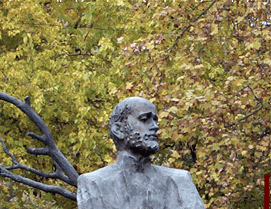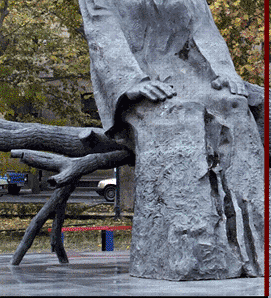|
KOMITAS IN THE MODERN ARMENIA October 22, 2005 marks the
70th anniversary of Komitas Vardapet’s death. However, all
this time the name of the great musician has lived not only in
his compositions, treatments, researches, poems, paintings, inspired
by his bright image, but also in daily life of his beloved and
native country, Armenia. |
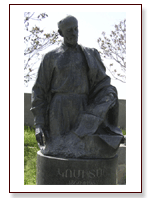 |
|
|
The gravestones of Aram Khachaturian,
Vahram Papazian, Sergey Parajanov, William Saroyan, Alexander Tamanian,
Avetik Isahakian, Vahan Terian, Hovhannes Abelian, Hrachia Nersisian
and others rise above the spacious alley.
Here every gravestone was designed in an individual style, reflecting not only the physical features of the hero, but also his creative nature. Thus, for instance, on the gravestone of a well-known actor Vahram Papazian one can see masks, and the actor himself is shown in the position typical of one of his heroes. On May 26, 1936 Komitas’ ashes were brought to the Pantheon and buried there. His magnificent sculpture with an open notebook in one hand stands on the round pedestal and reminds us of his inspired creativity and precious researches… What Armenia has today is Komitas’ dream that didn’t come true during his lifetime: it is well-known that all his life he dreamt of opening a higher musical institution on his motherland, for local preparation of professional music candidates. It is also well-known that he, being a brilliant teacher, repeatedly developed programs for teaching the Armenian musicians of various profiles. In 1921 a music studio was opened under the leadership of a famous Armenian composer Romanos Melikian in Yerevan. On its basis, on October 1, 1923, Yerevan State Conservatory was opened. After World War II, in 1946 the latter was named after Komitas. Yerevan Conservatory is the only musical institution of higher education in Armenia. On October 1, 2003, it celebrated its 80th anniversary. Throughout all these years the Conservatory has had numerous generations of graduates-musicians, who have performed the best stages of the world up to this day. Not only musicians, but the Conservatory itself that carries the name of Komitas, has gone through a long and interesting path of development. In the first years of its foundation it offered classes of piano, violin, alt, cello, wind instruments, vocal, choral singing, string quartet and teaching. In 1924-25 academic years the Conservatory organized the first Armenian symphonic orchestra. In 1926-27 the first opera studio was opened, in 1930-31 – a composition class, and a year later – classes of opera and symphony conducting. In 1937-38 academic years the Musicology department was founded, which allowed the students to obtain deep knowledge in the fields of music theory and history, art critique, harmony, polyphony, form analysis, and other. Postgraduate studies have functioned at the Conservatory since 1961; here the students who wish to continue to perfect their music education, have an opportunity to receive an academic degree of a Candidate of Arts after the defense. In the latter years the Conservatory opened a number of classes related to the problems of national folklore. In 1969 there was created the cabinet of national folklore, in 1978 – the cabinet of national instruments, in 1987 – the cabinet of national song, and in 1988 – the department of national folklore. Today the Conservatory also offers the departments of foreign students, foreign languages, social sciences and computer science, which contribute to the expansion of professional outlook of the students. In 1997 the department of jazz music was opened for future representatives of Armenia’s music. For its 80-year old path the Conservatory of Komitas has been developing under the leadership of bright musicians, famous composers and artists: |
||
|
 |
|
For
residents of Yerevan, Komitas is also the name of one of the major
streets. Komitas street was constructed in 1963-64. It is the most
popular link connecting the city center with Zeytun district. In 1996, Komitas Publishing House was established in Yerevan. It is a specialized musical publishing house founded by a musician and teacher Ruzanna Yesayan. The mission of the publishing house is to represent Armenian music all over the world, to promote the most significant works including those written by young talented composers, as well as to publish new musicological works. Most of the published materials are the first prints of the corresponding manuscripts. For the 8 years of successful work, Komitas Publishing House has issued about 60 items of musical literature including musical scores and books on music. The latter ones have been repeatedly represented at various international exhibitions in Moscow and Frankfurt. Komitas also pays special attention to Armenian folk and ashugh music. In 2004, Komitas Publishing House established a library where non-published manuscripts of Armenian composers of different periods are preserved. Komitas is a member of the National Publishers’Association. The publishing house collaborates with various musical schools and with distinguished figures of the national musical culture. Here is the list of the literature published by Komitas: |
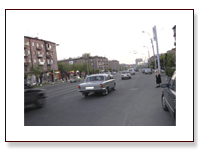 |
|
Music Gevork Ajemian Georgy Sarajian Musical Scores Ashot Satian-junior Vardan Ajemian |
Composers
of Artsakh Vocal works by young composers Manual on playing the duduk Concertos, quartets, collections of songs, choruses, educational materials, etc. Books V. Edigarian Digest of musicological works Anna Arevshatian |
 |
One
of the best concert halls of Yerevan, the Chamber Music Hall also
bears the name of Komitas. This small but very original building
was constructed in 1978 (architect: Stepan Kurkchian). It is located
in the city center, deep in the park. Nowadays, Komitas Chamber Music Hall hosts concerts of chamber, vocal-instrumental, choral
and organ music. Though the hall is not so large in size, it can
seat about three hundred. |
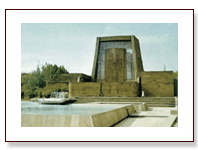 |
|
